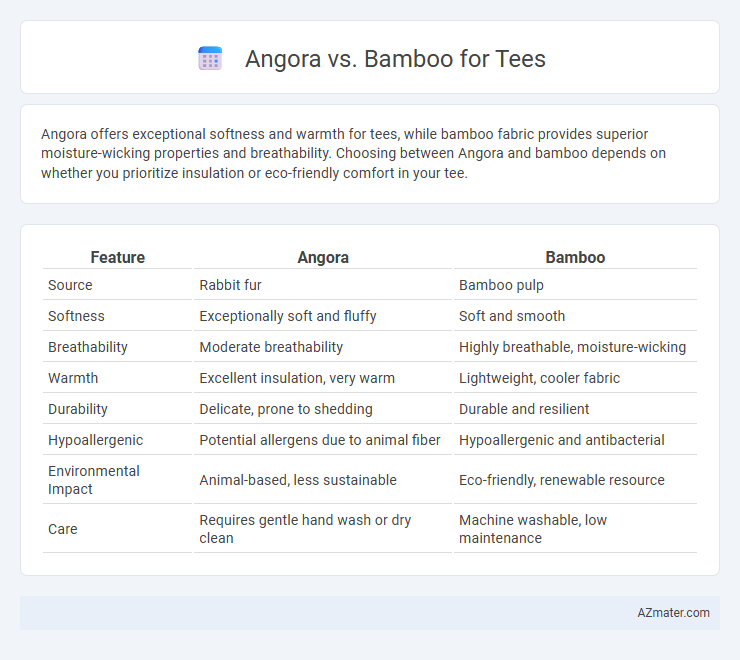Angora offers exceptional softness and warmth for tees, while bamboo fabric provides superior moisture-wicking properties and breathability. Choosing between Angora and bamboo depends on whether you prioritize insulation or eco-friendly comfort in your tee.
Table of Comparison
| Feature | Angora | Bamboo |
|---|---|---|
| Source | Rabbit fur | Bamboo pulp |
| Softness | Exceptionally soft and fluffy | Soft and smooth |
| Breathability | Moderate breathability | Highly breathable, moisture-wicking |
| Warmth | Excellent insulation, very warm | Lightweight, cooler fabric |
| Durability | Delicate, prone to shedding | Durable and resilient |
| Hypoallergenic | Potential allergens due to animal fiber | Hypoallergenic and antibacterial |
| Environmental Impact | Animal-based, less sustainable | Eco-friendly, renewable resource |
| Care | Requires gentle hand wash or dry clean | Machine washable, low maintenance |
Introduction: Angora vs Bamboo for Tees
Angora and bamboo fabrics offer distinct benefits for tees, with angora known for its exceptional softness and natural insulation derived from Angora rabbit fibers. Bamboo fabric is prized for its eco-friendly production, moisture-wicking properties, and breathability, making it ideal for activewear tees. Understanding the thermal regulation and sustainability aspects of each material helps consumers select the best fabric for comfort and performance.
Material Origins: Angora and Bamboo Explained
Angora wool, derived from the Angora rabbit, is prized for its exceptional softness, insulating properties, and natural warmth, making it a luxurious choice for tee fabrics. Bamboo fibers originate from the fast-growing bamboo plant, offering eco-friendly qualities such as breathability, moisture-wicking, and antibacterial benefits. Both materials reflect different sustainability approaches: Angora depends on animal fibers, while bamboo emphasizes plant-based renewability and reduced environmental impact.
Softness and Comfort: Which Feels Better?
Angora wool offers exceptional softness and a luxurious feel against the skin, providing warmth without bulk, making it ideal for cozy tees. Bamboo fabric excels in breathability and moisture-wicking properties, resulting in a silky, smooth texture that enhances comfort in warmer conditions. When comparing softness and comfort, Angora is preferable for cold-weather comfort, while bamboo is better suited for lightweight, breathable tees.
Breathability and Moisture Wicking
Angora fibers offer excellent breathability due to their natural hollow structure, allowing air circulation and keeping the body cool. Bamboo fabric excels in moisture-wicking capabilities, efficiently drawing sweat away from the skin to maintain dryness during physical activities. Combining Angora's breathability with Bamboo's moisture management creates an ideal blend for comfortable, temperature-regulated tees.
Durability and Longevity Comparison
Angora fibers are delicate with a tendency to shed and pill, resulting in reduced durability and shorter garment lifespan compared to bamboo. Bamboo fabric is highly resilient, moisture-wicking, and resistant to wear, offering superior longevity for tees with consistent use. Choosing bamboo over Angora ensures a more durable, sustainable, and longer-lasting clothing option.
Eco-Friendliness and Sustainability
Angora wool is biodegradable and renewable, but its production raises ethical concerns due to animal welfare issues and requires intensive farming practices. Bamboo fabric is highly sustainable, as bamboo grows quickly with minimal water and pesticides, and its fibers are biodegradable, though chemical processing in some bamboo textiles can impact eco-friendliness. Choosing bamboo tees with mechanically processed fibers ensures a lower environmental footprint compared to Angora, making them a more sustainable and eco-friendly option.
Allergen Considerations and Skin Sensitivity
Angora fibers, derived from Angora rabbits, are known for their softness but may trigger allergic reactions due to lanolin content, making them less suitable for sensitive skin. Bamboo fabric, made from bamboo pulp, is naturally hypoallergenic and moisture-wicking, reducing irritation and making it an excellent choice for individuals with allergies or sensitive skin. Choosing bamboo tees helps minimize allergen exposure and promotes skin comfort, especially for those prone to dermatitis or eczema.
Care and Maintenance Requirements
Angora fabric requires delicate care, including hand washing or gentle machine cycles with cold water, and air drying to prevent fiber damage and maintain softness. Bamboo fabric offers easier maintenance, as it is generally machine washable on gentle settings and dries quickly without losing shape or texture. Proper care extends the lifespan of both fabrics, but bamboo tees tend to be more resistant to shrinking and pilling compared to angora.
Style and Aesthetic Appeal
Angora fabric offers a luxurious, soft texture with a natural sheen that elevates tees with a refined, elegant look, making it ideal for sophisticated, high-end styles. Bamboo tees provide a smooth, matte finish and excellent drape, creating a casual yet sleek aesthetic that appeals to eco-conscious fashion enthusiasts. Both fibers enhance the tactile appeal, but Angora's distinctive fluffiness contrasts with Bamboo's minimalist smoothness, catering to different style preferences.
Verdict: Choosing the Best Tee Material
Angora offers exceptional softness and warmth, making it ideal for luxurious, cozy tees, while bamboo fabric excels in breathability, moisture-wicking, and sustainability, perfect for activewear and everyday comfort. Bamboo tees are naturally hypoallergenic and antimicrobial, enhancing durability and skin-friendliness compared to angora's delicate fibers. For a versatile, eco-friendly option, bamboo is the superior choice, whereas angora suits premium, cold-weather garments requiring superior softness.

Infographic: Angora vs Bamboo for Tee
 azmater.com
azmater.com